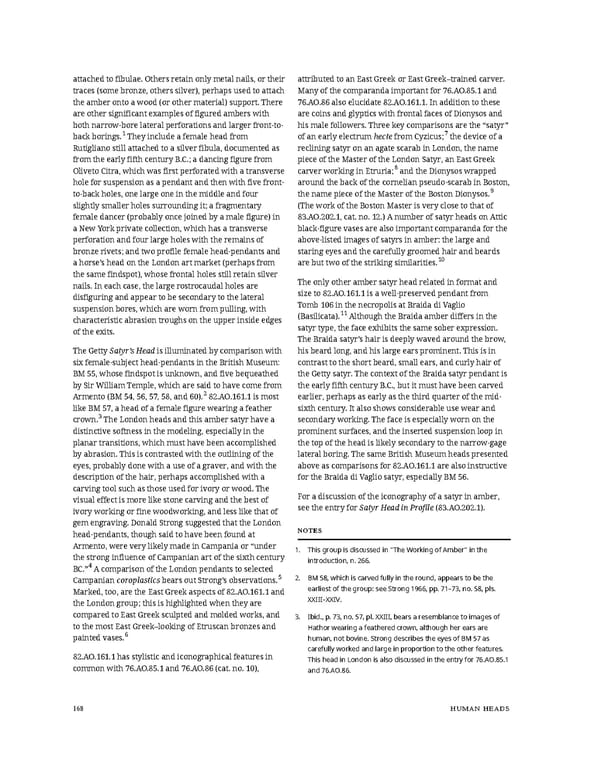attached to fibulae. Others retain only metal nails, or their attributed to an East Greek or East Greek–trained carver. traces (some bronze, others silver), perhaps used to attach Many of the comparanda important for 76.AO.85.1 and the amber onto a wood (or other material) support. There 76.AO.86also elucidate 82.AO.161.1. In addition to these are other significant examples of figured ambers with are coins and glyptics with frontal faces of Dionysos and both narrow-bore lateral perforations and larger front-to- his male followers. Three key comparisons are the “satyr” back borings.1 They include a female head from of an early electrum hecte from Cyzicus;7 the device of a Rutigliano still attached to a silver fibula, documented as reclining satyr on an agate scarab in London, the name from the early fifth century B.C.; a dancing figure from piece of the Master of the London Satyr, an East Greek Oliveto Citra, which was first perforated with a transverse carver working in Etruria;8 and the Dionysos wrapped hole for suspension as a pendant and then with five front- around the back of the cornelian pseudo-scarab in Boston, to-back holes, one large one in the middle and four the name piece of the Master of the Boston Dionysos.9 slightly smaller holes surrounding it; a fragmentary (The work of the Boston Master is very close to that of female dancer (probably once joined by a male figure) in 83.AO.202.1, cat. no. 12.) A number of satyr heads on Attic a New York private collection, which has a transverse black-figure vases are also important comparanda for the perforation and four large holes with the remains of above-listed images of satyrs in amber: the large and bronze rivets; and two profile female head-pendants and staring eyes and the carefully groomed hair and beards a horse’s head on the London art market (perhaps from are but two of the striking similarities.10 the same findspot), whose frontal holes still retain silver nails. In each case, the large rostrocaudal holes are The only other amber satyr head related in format and disfiguring and appear to be secondary to the lateral size to 82.AO.161.1 is a well-preserved pendant from suspension bores, which are worn from pulling, with Tomb 106 in the necropolis at Braida di Vaglio (Basilicata).11 Although the Braida amber differs in the characteristic abrasion troughs on the upper inside edges of the exits. satyr type, the face exhibits the same sober expression. The Braida satyr’s hair is deeply waved around the brow, The Getty Satyr’s Head is illuminated by comparison with his beard long, and his large ears prominent. This is in six female-subject head-pendants in the British Museum: contrast to the short beard, small ears, and curly hair of BM 55, whose findspot is unknown, and five bequeathed the Getty satyr. The context of the Braida satyr pendant is by Sir William Temple, which are said to have come from the early fifth century B.C., but it must have been carved Armento (BM 54, 56, 57, 58, and 60).2 82.AO.161.1 is most earlier, perhaps as early as the third quarter of the mid- like BM 57, a head of a female figure wearing a feather sixth century. It also shows considerable use wear and crown.3The London heads and this amber satyr have a secondary working. The face is especially worn on the distinctive softness in the modeling, especially in the prominent surfaces, and the inserted suspension loop in planar transitions, which must have been accomplished the top of the head is likely secondary to the narrow-gage by abrasion. This is contrasted with the outlining of the lateral boring. The same British Museum heads presented eyes, probably done with a use of a graver, and with the above as comparisons for 82.AO.161.1 are also instructive description of the hair, perhaps accomplished with a for the Braida di Vaglio satyr, especially BM 56. carving tool such as those used for ivory or wood. The visual effect is more like stone carving and the best of For a discussion of the iconography of a satyr in amber, ivory working or fine woodworking, and less like that of see the entry for Satyr Head in Profile (83.AO.202.1). gem engraving. Donald Strong suggested that the London NOTES head-pendants, though said to have been found at Armento, were very likely made in Campania or “under 1. This group is discussed in “The Working of Amber” in the the strong influence of Campanian art of the sixth century introduction, n. 266. BC.”4 A comparison of the London pendants to selected Campaniancoroplasticsbears out Strong’s observations.5 2. BM 58, which is carved fully in the round, appears to be the Marked, too, are the East Greek aspects of 82.AO.161.1 and earliest of the group: see Strong 1966, pp. 71–73, no. 58, pls. the London group; this is highlighted when they are XXIII–XXIV. compared to East Greek sculpted and molded works, and 3. Ibid., p. 73, no. 57, pl. XXIII, bears a resemblance to images of to the most East Greek–looking of Etruscan bronzes and Hathor wearing a feathered crown, although her ears are painted vases.6 human, not bovine. Strong describes the eyes of BM 57 as carefully worked and large in proportion to the other features. 82.AO.161.1 has stylistic and iconographical features in This head in London is also discussed in the entry for 76.AO.85.1 common with76.AO.85.1 and 76.AO.86(cat. no. 10), and 76.AO.86. 168 HUMAN HEADS
 Ancient Carved Ambers in the J. Paul Getty Museum Page 177 Page 179
Ancient Carved Ambers in the J. Paul Getty Museum Page 177 Page 179